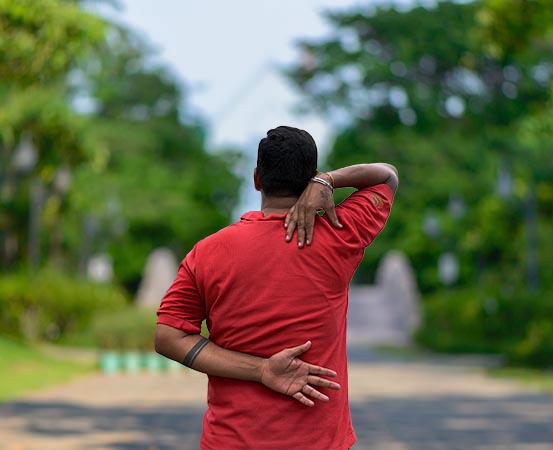
Stiffness or pain in the neck or the upper back region is common, so much so that you could come across someone suffering from it daily. Bad posture and a sedentary lifestyle are the major culprits here. At times, neck pain is caused not just by the stiffness in the neck muscles. Any form of stiffness or imbalance in the adjoining muscles also triggers it. The most common among these is trapezius muscle strain.
The pain, which ranges from mild to chronic, mostly subsides on its own. However, sometimes, medical intervention is required.
What is the trapezius?
The trapezius muscle — shaped like a trapezoid — is a superficial muscle comprising long fibers spanning the width of the upper back. The trapezius allows the spinal column to remain erect while standing. It is also involved in movements such as bending to the sides, rotating the head, elevating and depressing the shoulders and scapula, and the internal rotation of the arms.
Trapezius muscle strain: Causes
“The most common causes for a strain in the trapezius muscles are bad posture and lifestyle issues,” explains Bishwaranjan Das, musculoskeletal and sports injury specialist at Manipal Health Enterprises, Mangalore, Karnataka. “A strain or spasm in the trapezius often results from lifestyle disorders. People having desk jobs stare at the computer screen for long hours by keeping their necks and shoulders in an inappropriate position. Teachers crane their necks while writing on the blackboard. Driving for long hours or lifting heavy loads can also lead to straining this muscle.”
Experts observe that before the pandemic, the occurrence of this strain was fairly rare. “Before Covid-19, about one in a hundred people would come to us for this issue. However, currently, this number has risen to about 34 out of 100,” shares Das. “During the pandemic, physical activity levels among people reduced. Most were working from home, which resulted in a sedentary lifestyle. And people are now suddenly becoming active, which is leading to this problem.”
Symptoms of trapezius muscle strain
The most common symptoms of trapezius muscle strain are:
- Trouble doing day-to-day activities like putting on a shirt or other movements involving the shoulder.
- Stiffness in the neck and back, accompanied by pain in the shoulder blade
- Muscle spasms.
- Hardening of the muscles — the affected area becomes hard as stone.
- Severe strain in the affected muscle with swelling and redness.
Trapezius strain treatment
It is vital to get the strain evaluated by an orthopedic or physiotherapist. If ignored, the pain can become chronic. It can lead to persistent neck stiffness, which affects the quality of life, and can also result in complications like nerve entrapment.
The treatment for trapezius muscle strain aims at releasing the spasm or stiffness. Das explains, “We can treat the tightness by massaging or stretching, followed by muscle flexibility exercises. Correcting the posture along with proper strengthening of the neck, shoulder, and upper back muscles are part of the exercise program.” Muscle relaxants, physiotherapy modalities, ultrasonic therapy, moist heat, or hot fomenting are used to relieve the discomfort.
A regular exercise routine and an active lifestyle, along with measures to correct posture, can help one avoid trapezius strain, adds Das.
Takeaways
- Trapezius muscle strain is caused by poor posture and an inactive or sedentary routine.
- Symptoms include stiffness in the neck and the back, felt only when it affects the shoulder blades.
- If ignored, this can lead to chronic pain and persistent stiffness in the muscles, as well as complications like nerve entrapment.

















